| 1. | ||
| 2. | ||
| 3. | ||
| 4. | ||
| 5. | ||
| 5.1. | ||
| 5.2. | ||
Molecular Cloud Formation Through Transverse Thermal Instability of Radiative Plasma with Finite Electron Inertia and Finite Larmor Radius Corrections
Sachin Kaothekar
Department of Physics, Mahakal Institute of Technology, Madhya Pradesh, India
Email address

Citation
Sachin Kaothekar. Molecular Cloud Formation Through Transverse Thermal Instability of Radiative Plasma with Finite Electron Inertia and Finite Larmor Radius Corrections. International Journal of Modern Physics and Application. Vol. 3, No. 5, 2016, pp. 57-65.
Abstract
For the formation of molecular clouds, the effects of finite ion Larmor radius (FLR) corrections, finite electron inertia and radiative heat-loss function on the thermal instability of an infinite homogeneous, viscous plasma incorporating the effects of thermal conductivity, permeability has been investigated. A general dispersion relation is derived using the normal mode analysis method with the help of relevant linearized perturbation equations of the problem. The wave propagation is discussed for transverse direction to the external magnetic field and the condition of modified thermal instabilities and stability are discussed in different cases. It is found that the thermal instability criterion is get modified into radiative instability criterion because of inclusion of radiative heat-loss functions. The viscosity of the medium removes the effect of FLR corrections from the condition of radiative instability. Numerical calculation shows stabilizing effect of heat-loss function, FLR corrections, viscosity and destabilizing effect of finite electron inertia on the thermal instability.
Keywords
Molecular Cloud Formation, Thermal Instability, Magnetohydrodynamics (MHD), Finite Electron Inertia, FLR Corrections
1. Introduction
Molecular cloud formation in interstellar medium is one of the most promising and fundamental phenomenon in astronomy and astrophysics. It is pertained that molecular clouds are formed due to thermal instability and gravitational instability, but thermal instability takes places in a medium which can turn out to be cooler owing to radiation and fluid reduction. Additional, reduction in the temperature constructs the arrangement unbalanced and directs to formation of novel configurations due to density strengthening. In this instability, the critical length scale is smaller than that of the other dynamical instability like the Jeans instability i.e. a system can become thermally unbalanced even if the organization is stable beside the gravitational instability. Hence, we can say that the physical basis of smaller scale configurations is owing to thermal instability quite than the energetically instability. It is straightly correlated with the structure of unlike stages in disperse interstellar and intergalactic intermediate, as well as in the solar atmosphere. The thermal and radiative instability arising due to various heat-loss mechanisms definitely be the cause of astrophysical condensation and the formation of large scale structures as well as small objects. Many authors investigated the phenomenon of thermal instability arising due to heat-loss mechanism in plasma.
Field [1] has discussed the importance of thermal instability in the formation of solar prominences, condensation in planetary nebula and condensation of galaxies from the intergalactic medium. Hunter [2] has discussed the role of thermal instability in star formation. Raju [3] has emphasis on the role of thermal instabilityin the formation of solar prominences. Aggarwal & Talwar [4] have investigated magnetothermalinstability in a rotating gravitating fluid taking radiative heat-loss function. Ibanez [5] has studied the sound and thermal waves in a fluid with an arbitrary heat-loss function. Hoven & Mok [6] have carried out the problem of thermal instability in a sheared magnetic field. Burkert & Lin [7] have pointed out the importance of thermal instability in the formation of clumpy gas clouds and they showed that the thermal instability can lead to the breakup of large clouds into cold dense clumps. Nejad-Asghar & Ghanbari [8] have discussed the formation of small scale condensation in the molecular clouds via thermal instability. Baruah et al. [9] have studied the thermal (radiative) instability in weakly ionized plasma with continuous ionization and recombination taking general heat-loss function. Fukue & Kamaya [10] have carried out the problem of gravitational instability in a rotating gravitating fluid taking radiative heat-loss function. Bora & Talwar [11] have investigated arbitrary radiative heat-loss function and electron inertia. Prajapati et al. [12] have carried out the problem of self-gravitational instability of rotating viscous Hall plasma with arbitrary radiative heat-loss functions and electron inertia. Recently Kaothekar et al. [13] have carried out the effect of neutral collision and radiative heat-loss function on self-gravitational instability of viscous thermally conducting partially-ionized plasma. More recently Kaothekar & Chhajlani [14] have investigated the problem of Jeans instability of self gravitating partially ionized Hall plasma with radiative heat loss functions and porosity.
In addition to this electron inertia parameter is important in the dynamics of interstellar matter, magnetic reconnections processes, in stability investigation of accelerated plasmas and in several other astrophysical situations. Kalra & Talwar [15] have investigated magneto-thermal instability of unbounded plasma with electron inertia and Hall effect. Tayler [16] has discussed a simple hydromagnetic stability problem involving finite conductivity, electron inertia and Hall effect. Chatterjee & Das [17] have pointed out the effect of electron inertia on the speed and shape of ion-acoustic solitary waves in plasma. Shukla et al. [18] have studied the effect of electron inertia on kinetic Alfven waves. Damiano et al. [19] have pointed out the effects of electron inertia and FLR on Hall magnetohydrodynamicwaves. Uberoi [20] has discussed electron inertia effects on the transverse gravitational instability incorporating the rotation parameters. Deka & Dwivedi [21] have investigated the effect of electron inertial delay on Debye sheath formation. Dangarh et al. [22] have examined the analysis of Jeans instability of partially-ionized molecular cloud under influence of radiative effect and electron inertia. Patidar et al. [23] have carried out the effect of electron inertia on radiative instability of rotating two-component gaseous plasma. Recently Pensia et al. [24] have carried out the effect of self-gravitating viscous radiative and thermally conducting gaseous plasma in the presence of fine-dust-particles under the effect of finite electron inertia and heat-loss function. Litvinenko & McMahon [25] have investigated Hall MHD and electron inertia effects in current sheet formation at a magnetic neutral line.
In addition to this the effect of finite ion Larmor radius (FLR) corrections is very important in astrophysical plasma situations. In several astrophysical plasma conditions such as in solar corona, interstellar and interplanetary plasmas the assumption of zero Larmor radius is not valid. Roberts & Taylor [26] has shown the stabilizing influence of finite ion Larmor radius (FLR) effects on plasma instabilities. Bhatia [27] has investigated the gravitational instability of a rotating anisotropic plasma with the inclusion of FLR corrections. Bhatia & Maheshwari [28] have investigated the gravitational instability of a rotating viscous finitely conducting plasma. Chhajlani & Sanghvi [29] have carried out the problem of magnetogravitational stability of self-gravitating plasma with thermal conduction and FLR through porous medium. Herrnegger [30] has investigated the stabilizing effect of FLR on gravitational instability and shows that gravitational criterion is changed by FLR for wave propagation perpendicular to magnetic field. Vaghela & Chhajlani [31] have studied the stabilizing effect of FLR on magneto-thermal stability of resistive plasma through porous medium with thermal conduction. Chhajlani & Parihar [32] have carried out the stabilizing effect of FLR on magnetogravitational instability of anisotropic plasma with generalized polytrope laws. Farraro [33] has investigated the stabilizing effect of FLR on magnetorotational instability. Sharma & Chhajlani [34] have carried out the effect of FLR corrections on Jeans instability of quantum plasma. Recently Kaothekar & Chhajlani [35] have carried out the problem of Jeans instability of self-gravitating rotating radiative plasma with finite Larmor radius corrections. More recently Kaothekar et al. [36] have investigated the problem of Jeans instability of partially-ionized self-gravitating viscous plasma with Hall effect FLR corrections and porosity. Thus FLR effect is an important factor in discussion of thermal instability and other hydromagnetic instability.
In the glow of above research, we find that in these studies (Bora & Talwar [11], Prajapati et al. [12], and Kaothekar et al. [36]) the joint influence of FLR corrections, electron inertia, radiative heat-loss functions, viscosity, permeability, thermal conductivity and magnetic field on the thermal instability is not investigated. Therefore in present work thermal instability of viscous magnetized plasma with electron inertia, FLR corrections, permeability, radiative heat-loss functions and thermal conductivity is studied.
2. Equations of the Problem
Allow us thin kinfinite homogeneous, radiating, viscous, thermally conducting, plasma with finite electron inertia in the presence of magnetic field H (0, 0, H). The equations of the problem with these effects are written as-
 (1)
(1)
![]() , (2)
, (2)
![]() , (3)
, (3)
![]() , (4)
, (4)
 , (5)
, (5)
![]() , (6)
, (6)
Where p, ρ, υ, T, ![]() (vx, vy, vz),
(vx, vy, vz), ![]() , R,
, R, ![]() denote the fluid density, pressure, kinematic viscosity, temperature, velocity, thermal conductivity, gas constant, permeability and ratio of two specific heats, velocity of light and electron plasma frequency respectively. Here L(ρ, T) is the heat-loss function per gram of the material per second exclusive of thermal conduction and is in general a function of the local values of density and temperature. The operator
denote the fluid density, pressure, kinematic viscosity, temperature, velocity, thermal conductivity, gas constant, permeability and ratio of two specific heats, velocity of light and electron plasma frequency respectively. Here L(ρ, T) is the heat-loss function per gram of the material per second exclusive of thermal conduction and is in general a function of the local values of density and temperature. The operator ![]() is the substantial derivative given as
is the substantial derivative given as ![]() = (
= (![]() +
+![]() ).
). ![]() is the pressure tensor taking into account the effect of finite ion gyration radius for the magnetic field along z axis as given by Roberts & Taylor [26] is
is the pressure tensor taking into account the effect of finite ion gyration radius for the magnetic field along z axis as given by Roberts & Taylor [26] is
 (7)
(7)
The parameter ![]() has the dimensions of the kinematics viscosity and defined as
has the dimensions of the kinematics viscosity and defined as ![]() , where
, where ![]() is the ion-Larmor radius and
is the ion-Larmor radius and ![]() is the ion gyration frequency.
is the ion gyration frequency.
3. Perturbation Equations of the Problem
The perturbation in fluid pressure, density, temperature, velocity, magnetic field, heat-loss function are given as δp, δρ, δT, v(vx, vy, vz), ![]() (
(![]() ,
,![]() ,
,![]() ) and
) and ![]() respectively. The perturbation state is given as
respectively. The perturbation state is given as
p = p0 + δp, T = T0+ δT, ρ = ρ0 + δρ, v = v0 + v (with v0= 0),
H= H0+![]() , and L = L0 + L (with L0 = 0). (8)
, and L = L0 + L (with L0 = 0). (8)
Suffix ‘0’ represents the initial equilibrium state, which is independent of space and time, and can be dropped from the equilibrium quantities for the sake of simplifications.
Substituting the perturbation state into equation (1) to (7) and linearizing them by neglecting higher order perturbations.
The linearized perturbation equations of motion for such medium are
 (9)
(9)
![]() (10)
(10)
![]() (11)
(11)
![]() (12)
(12)
 (13)
(13)
![]() (14)
(14)
Where ![]() and
and ![]() respectively denote partial derivatives
respectively denote partial derivatives ![]() and
and ![]() of the heat-loss function evaluated for the initial (unperturbed) state.
of the heat-loss function evaluated for the initial (unperturbed) state.
4. Dispersion Relation
We seek plain wave solution of the form
exp![]() (15)
(15)
Where ![]() is the frequency of harmonic disturbance and
is the frequency of harmonic disturbance and ![]() is the wave number of the perturbation along x axis, such that
is the wave number of the perturbation along x axis, such that ![]() .
.
The components of equation (13) may be given as
![]() ,
,
![]() , (16)
, (16)
![]() ,
,
Using equations (11), (12) and (16) we write
 (17)
(17)
Using equations (10)-(18) in equation (9), we may write the following algebraic equations for the components of equation (9)

![]() , (18)
, (18)

 (19)
(19)
 (20)
(20)
Taking divergence of equation (9) and using equation (10) to (18), we obtain as

 (21)
(21)
The set of equations (19)-(21) can be written in the form.
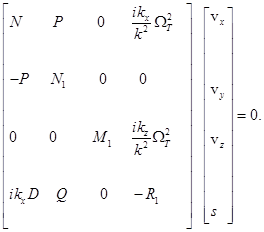 (22)
(22)
We have made following assumptions
 (23)
(23)
![]() ,
,
is the adiabatic velocity of sound in the medium,
![]() ,
,
is the condensation of the medium.
The general dispersion relation can be obtained from the determinant of matrix of equation (23) is


 (24)
(24)
The dispersion relation (24) represents the combined influence of viscosity, magnetic field, thermal conductivity, radiative heat-loss function, permeability and finite electron inertia, FLR corrections on thermal instability of plasma. In absence of FLR corrections dispersion relation (24) is identical to Prajapati et al. [12] for non-rotational, non-gravitational and infinite conducting case. In absence of FLR corrections and viscosity dispersion relation (24) is identical to and for infinite conducting case. Also in absence of FLR corrections, viscosity and finite electron inertia dispersion relation (24) is reduces to that obtained by Field [1]. Now we discuss the general dispersion relation (24) for longitudinal and transverse wave propagation.
5. Discussion
5.1. Transverse Propagation kx=k
In this case the perturbations are taken to be perpendicular to the direction of the magnetic field ![]() . The dispersion relation (24) reduces to
. The dispersion relation (24) reduces to
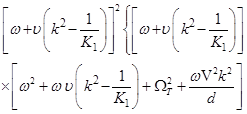
![]() (25)
(25)
The first component of the dispersion relation (26) gives
 (26)
(26)
This represents a stable viscous mode modified by the presence of permeability of the medium.
The second component of the dispersion relation (26) on simplifying gives



 (27)
(27)
The above equation represents the combined influence of radiative heat-loss function, FLR corrections, finite electron inertia, permeability, thermal conductivity, viscosity, and magnetic field on thermal instability of plasma. If we neglect the effect of FLR corrections equation (28) is identical to Prajapati et al. [12] for non rotational case. In the present case we have considered the effects of FLR corrections, but Prajapati et al. [12] have not considered this effect. Thus the dispersion relation in the present analysis is modified due to the presence of FLR corrections, but the condition of instability is unaffected by the presence of FLR corrections. Thus we conclude that FLR corrections has no effect on the condition of radiative instability, but the growth rate of the dispersion relation given by Prajapati et al. [12] gets modified due to the presence of FLR corrections in our present case. Thus we conclude that FLR corrections modify the growth rate of radiative instability in the present case. Hence this is the new finding in our case than that of Prajapati et al. [12].
When constant term of equation (28) is less than zero this allows at least one positive real root which corresponds to the instability of the system. The condition of instability obtained from constant term of equation (28) is given as
 (28)
(28)
The above inequality (28) is reduced form of Bora and Talwar [11].
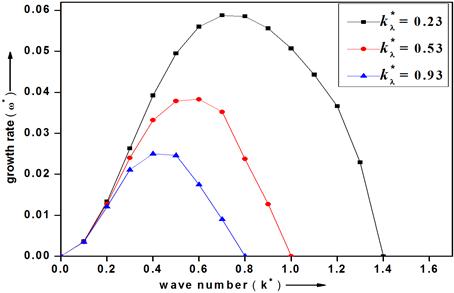
Figure 1. The normalized growth rate (![]() ) as a function of normalized wave number (
) as a function of normalized wave number (![]() ) for different values of
) for different values of ![]() with
with ![]() = 0.5 and
= 0.5 and ![]()
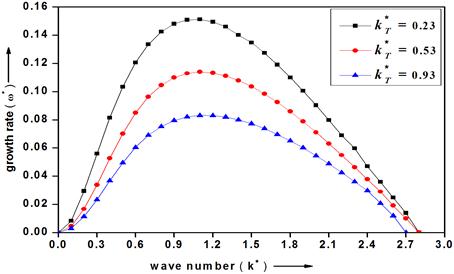
Figure 2. The normalized growth rate (![]() ) as a function of normalized wave number (
) as a function of normalized wave number (![]() ) for different values of
) for different values of ![]() with
with ![]() = 0.1 and
= 0.1 and ![]()
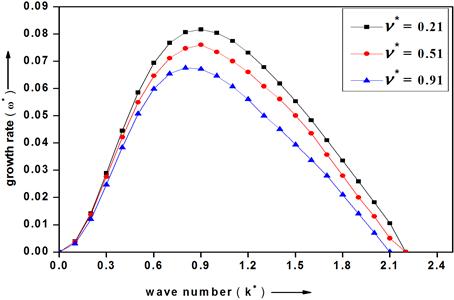
Figure 3. The normalized growth rate (![]() ) as a function of normalized wave number (
) as a function of normalized wave number (![]() ) for different values of
) for different values of ![]() with
with ![]() = 0.5 and
= 0.5 and ![]()
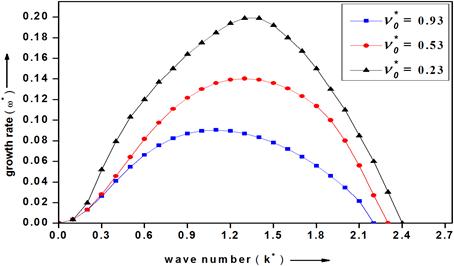
Figure 4. The normalized growth rate (![]() ) as a function of normalized wave number (
) as a function of normalized wave number (![]() ) for different values of
) for different values of ![]() with
with ![]() =0.1,
=0.1, ![]() = 0.5 and
= 0.5 and ![]()
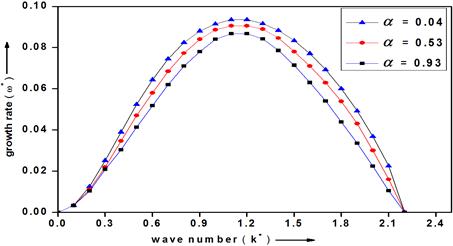
Figure 5. The normalized growth rate (![]() ) as a function of normalized wave number (
) as a function of normalized wave number (![]() ) for different values of
) for different values of ![]() having
having ![]() with
with ![]() = 0.5 and
= 0.5 and ![]()
In Figs. 1-5 the dimensionless growth rate (![]() ) has been plotted against the dimensionless wave number (
) has been plotted against the dimensionless wave number (![]() ) to see the effect of various physical parameters such as rotation, radiative heat-loss function, resistivity and FLR corrections. From Fig. 1 we see that as the value of
) to see the effect of various physical parameters such as rotation, radiative heat-loss function, resistivity and FLR corrections. From Fig. 1 we see that as the value of ![]() increases the growth rate decreases. Thus the effect of parameter
increases the growth rate decreases. Thus the effect of parameter ![]() is stabilizing. It is clear from Fig. 2 we conclude that growth rate decreases with increasing parameter
is stabilizing. It is clear from Fig. 2 we conclude that growth rate decreases with increasing parameter ![]() . Thus the presence of
. Thus the presence of ![]() stabilizes the growth rate of the system. From Fig. 3 we conclude that that growth rate decreases with increasing the value of viscosity. Thus the effect of viscosity is stabilizing. Figure 4 displays the influence of FLR corrections on the growth rate of thermal instability. From figure it is clear that the FLR corrections have a stabilizing effect on the growth rate of thermal instability. Figure 5 displays the influence of finite electron inertia on the growth rate of thermal instability. From figure it is clear that the finite electron inertia has a destabilizing effect on the growth rate of thermal instability. Therefore, the parameters radiative heat-loss functions, viscosity have stabilizing influence on the system while the finite electron inertia have destabilizing influence on the growth rate of the system.
stabilizes the growth rate of the system. From Fig. 3 we conclude that that growth rate decreases with increasing the value of viscosity. Thus the effect of viscosity is stabilizing. Figure 4 displays the influence of FLR corrections on the growth rate of thermal instability. From figure it is clear that the FLR corrections have a stabilizing effect on the growth rate of thermal instability. Figure 5 displays the influence of finite electron inertia on the growth rate of thermal instability. From figure it is clear that the finite electron inertia has a destabilizing effect on the growth rate of thermal instability. Therefore, the parameters radiative heat-loss functions, viscosity have stabilizing influence on the system while the finite electron inertia have destabilizing influence on the growth rate of the system.
Now we wish to examine the effect of finite electron inertia, FLR corrections and radiative heat-loss functions on the considered system with some simplifications and at the same time we wish to investigate the physics involved in such simplifications in the present problem.
In absence of thermal conductivity ![]() equation (28) reduces to
equation (28) reduces to


 (29)
(29)
The condition of instability obtained from constant term of equation (30) is given as
 (30)
(30)
On comparing equation (28) and (30) we see that no new mode comes due to inclusion of thermal conductivity, but the condition of instability and growth rate of in stability both get modified by inclusion of thermal conductivity.
Also on comparing equation (30) with equation (29) of Aggarwal & Talwar [4] we conclude that the growth rate of radiative instability is get modified by inclusion of finite electron inertia, FLR corrections and in our case, but condition of instability is independent of finite electroninertia and FLR corrections.
In absence of viscosity ![]() equation (28) becomes
equation (28) becomes

 (31)
(31)
The condition of instability obtained from constant term of equation (32) is given as. The above equation is identical to Bora & Talwar [11] in absence of FLR corrections.
The condition of instability obtained from constant term of equation (32) is given as

 (32)
(32)
From equation (33) we see that FLR corrections and magnetic field tries to stabilize the radiative instability. This is same as given by Bora and Talwar [11]. From equations (33) conclude that condition of radiative instability and the growth rate given by Bora and Talwar [11] is modified by inclusion of FLR corrections, thus the present results are the improvement of Bora & Talwar [11].
In absence of viscosity, thermal conductivity and radiative heat-loss function ![]() equation (28) becomes
equation (28) becomes
 (33)
(33)
The above equation (34) is the modified form of Uberoi [19] by inclusion of FLR corrections in our problem. The condition of instability obtained from equation (34) is given as
 (34)
(34)
From equation (35) we see that magnetic field and FLR corrections stabilize the system. On comparing equations (28) and (35) we see that dispersion relation given by Uberoi [19] is modified by inclusion FLR corrections, radiative heat-loss function, thermal conductivity and viscosity in our case. Hence we improve the result of Uberoi [19].
Thus we conclude that for transverse wave propagation the thermal criterion is affected by finite electron inertia, FLR corrections, radiative heat-loss functions, viscosity, magnetic field strength and thermal conductivity. But there is no effect of Hall parameter in transverse mode. From curves we find that FLR corrections and temperature dependent heat-loss function have stabilizing influence on the growth rate of self-thermal instability, where as density dependent heat-loss function and finite electron inertia have destabilizing influence on the thermal instability of plasma.
5.2. Conclusions
Thermal instability for molecular cloud formation has been studied incorporating the effects of viscous, permeability, thermally, radiative heat-loss functions, FLR corrections and finite electron inertia. The transverse wave propagation to the direction of external magnetic field has been considered. It is find that thermal criterion remains valid and gets modified because of radiative heat-loss function and thermal conductivity. For transverse wave propagation FLR corrections, magnetic field strength and viscosity affect the condition of radiative instability. FLR corrections stabilize the system in case of non-viscous medium. Also, magnetic field stabilizes the system. Numerical calculation shows stabilizing effect of heat-loss function, FLR corrections, viscosity and destabilizing effect of finite electron inertia on the self-thermal instability.
Acknowledgements
Author S. K. is grateful to Er. Praveen Vashishtha, Chairman Mahakal Institute of Technology, and Dr. Vivek Bansod, Director MIT Ujjain, for continuous support.
References